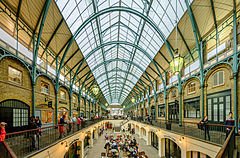「寫作這本書的時候,狄更斯的住處多是在柯芬園,他經常從這裡出發,四處明察暗訪,看教堂、濟貧院、墓園,但有時散步只是因為失眠,柯芬園有熱鬧的市集、戲院,但狄更斯形容它是過氣的鄰里,天氣一壞就顯得特別荒涼陰鬱。」
-圖文摘自《非商業旅人》http://www.bookrep.com.tw/activeimg/L/0LGB0002/#c
去過東倫敦的柯芬園嗎?你對那裡有什麼印象呢?

From Wikipedia, the free encyclopedia
For other uses, see Covent Garden (disambiguation).
Covent Garden

The interior of the former vegetable market


Covent Garden
 Covent Garden shown within Greater London
Covent Garden shown within Greater LondonOS grid reference TQ303809
London borough Westminster
Camden
Ceremonial county Greater London
Region London
Country England
Sovereign state United Kingdom
Police Metropolitan
Fire London
Ambulance London
EU Parliament London
UK Parliament Cities of London and Westminster
Holborn and St. Pancras
London Assembly West Central
Barnet and Camden
List of places UKEnglandLondon
Coordinates:
 51.51197°N 0.1228°W
51.51197°N 0.1228°WCovent Garden (/ˈkɒvənt/) is a district in London on the eastern fringes of theWest End, between St. Martin's Lane and Drury Lane.[1] It is associated with the former fruit and vegetable market in the central square, now a popular shopping and tourist site, and the Royal Opera House, which is also known as "Covent Garden". The district is divided by the main thoroughfare of Long Acre, north of which is given over to independent shops centred on Neal's Yard andSeven Dials, while the south contains the central square with its street performers and most of the elegant buildings, theatres and entertainment facilities, including the Theatre Royal, Drury Lane, and the London Transport Museum.
Though mainly fields until the 16th century, the area was briefly settled when it became the heart of the Anglo-Saxon trading town of Lundenwic.[2] After the town was abandoned, part of the area was walled off by 1200 for use as arable land and orchards by Westminster Abbey, and was referred to as "the garden of the Abbey and Convent". The land, now called "the Covent Garden", was seized by Henry VIII, and granted to the Earls of Bedford in 1552. The 4th Earlcommissioned Inigo Jones to build some fine houses to attract wealthy tenants. Jones designed the Italianate arcaded square along with the church of St Paul's. The design of the square was new to London, and had a significant influence on modern town planning, acting as the prototype for the laying-out of new estates as London grew.[3] A small open-air fruit and vegetable market had developed on the south side of the fashionable square by 1654.
Gradually, both the market and the surrounding area fell into disrepute, as taverns, theatres, coffee-houses and brothels opened up; the gentry moved away, and rakes, wits and playwrights moved in.[4] By the 18th century it had become a well-known red-light district, attracting notable prostitutes. An Act of Parliament was drawn up to control the area, and Charles Fowler's neo-classical building was erected in 1830 to cover and help organise the market. The area declined as a pleasure-ground as the market grew and further buildings were added: the Floral Hall, Charter Market, and in 1904 the Jubilee Market. By the end of the 1960s traffic congestion was causing problems, and in 1974 the market relocated to the New Covent Garden Market about three miles (5 km) south-west at Nine Elms. The central building re-opened as a shopping centre in 1980, and is now a tourist location containing cafes, pubs, small shops, and a craft market called the Apple Market, along with another market held in the Jubilee Hall.
Covent Garden, with the postcode WC2, falls within the London boroughs of Westminster and Camden, and the parliamentary constituencies of Cities of London and Westminster and Holborn and St Pancras. The area has been served by the Piccadilly line at Covent Garden tube station since 1907; the journey from Leicester Square, at 300 yards, is the shortest on the London Underground.
沒有留言:
張貼留言